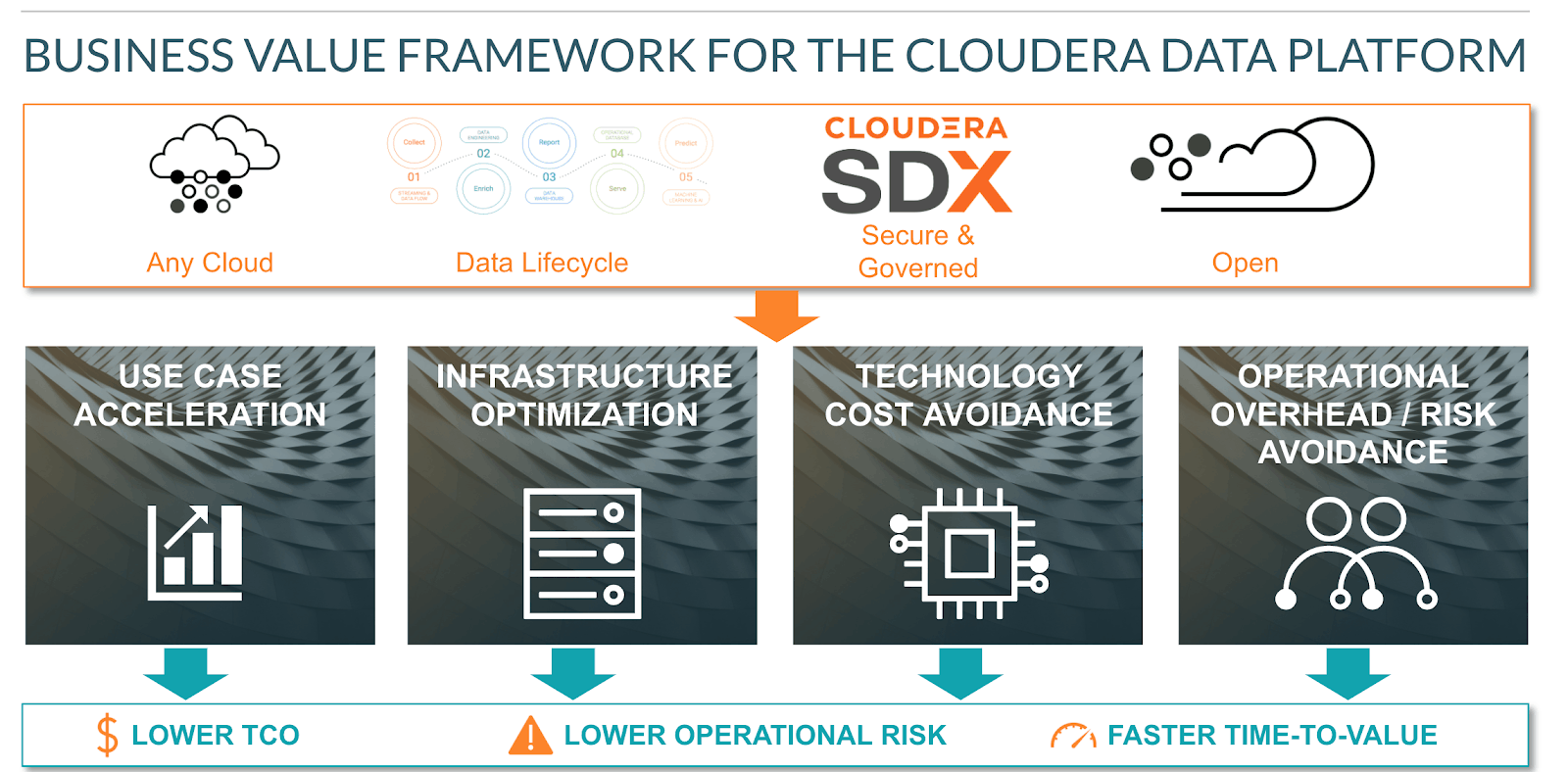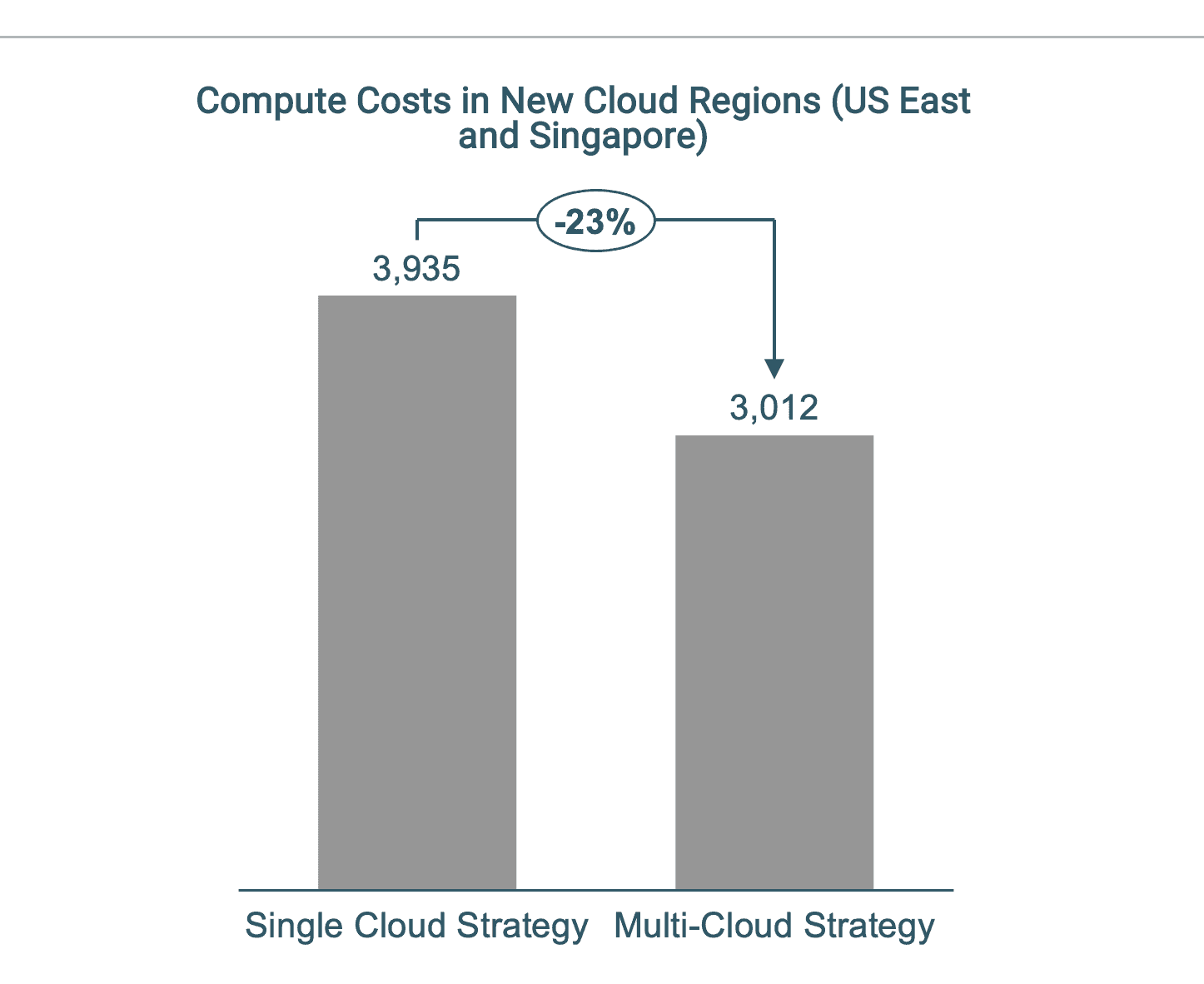Introduction
In the introductory article of this series I presented the overarching framework for quantifying the value of the Cloudera Data Platform (CDP):

In this article I will be focusing on the contribution that a multi-cloud strategy has towards these value drivers, and address a question that I regularly get from clients: Is there a quantifiable benefit to a multi-cloud deployment? That question is typically being asked when I explain the ability to leverage container technology that offers a consistent deployment environment across multiple clouds and form factors (public, private, or hybrid cloud). The answer is, yes, there are direct, quantifiable benefits by employing cloud arbitrage strategies, in addition to the broader, strategic advantages that a multi-cloud capability has.
A prerequisite for those benefits is using a data platform that breaks down cloud, workload and data silos and is able to seamlessly move workloads between deployment environments in a frictionless manner, capabilities that CDP Public Cloud delivers out of the box. However, while many organizations have established relationships with multiple cloud vendors to achieve a multi-cloud model, they are using advanced analytics solutions that introduce cloud and data silos that diminish the value of that model. To expand more on the shortcomings of current multi-cloud models, a recent Flexera report highlights that, among the organizations that have deployed multi-cloud, almost half of them isolate workloads by cloud and only 42% leverage multi-cloud management tools. These are capability and architectural gaps that the Cloudera Data Platform helps address with components such as Replication Manager, the Shared Data Experience and Workload Manager that I describe in a later section of this article.
In the following sections I present the approach for quantifying the value of multi-cloud deployments by also including some relevant client examples.
A. Infrastructure Cost Optimization
In a recent client situation, the Client had already started migrating their on-premises workloads to their primary CSP’s infrastructure in Europe and they were planning to replicate the same deployment model globally. To demonstrate how CDP Public Cloud would help to optimize infrastructure costs, I conducted a relative quantitative comparison between two scenarios:
- The initial scenario (“Status Quo”), in which the Client deploys CDP Public Cloud in the remaining regions (North America and Singapore) on the incumbent CSP’s cloud (“CSP A”)
- The alternative scenario, in which the Client would select CSP between the two available options (the incumbent – or “CSP A” and their secondary cloud infrastructure provider – or “CSP B”) based on compute cost optimization criteria:
| Region | Germany (Primary Market) | North America (US East Region) | APAC (Singapore) |
| A. Status Quo | CSP A | CSP A | CSP A |
| B. Infrastructure Optimization | CSP A | CSP selection based on infrastructure TCO | CSP selection based on infrastructure TCO |
CDP Public Cloud costs are excluded in this comparison because hourly pricing for CDP Public Cloud credits is the same across CSPs for similar instance types (similar by means of instance class and compute capacity in vCPUs) irrespective of technical use case. In addition, we are only accounting for compute costs because they represent the highest proportion of costs, also excluding the following items for the sake of simplicity:
- Object storage costs (similar unit costs across CSPs) and
- Networking costs (relatively small impact on total infrastructure costs)
The workload breakdown measured in estimated vCPU-hours (based on on-premises capacity and utilization metrics) by region and data lifecycle stage is summarized in the Shankey chart below: 
From an instance type standpoint, the chart below shows the breakdown of compute hours by type of instance across all the experiences and regions (measured in estimated vCore-hours):

In the quantitative analysis that follows, we are using pricing for Red Hat Enterprise Linux instances (Client’s operating system of choice) and we have selected the optimal available billing type in terms of reserved capacity option and commitment term for each instance type in each region.
By using list prices for compute based on information provided by both CSPs, I calculated compute costs for each scenario based on expected consumption volumes / workload patterns (amounts in $K):
| Region | Germany (Primary Market) | North America (US East Region) | APAC (Singapore) |
| CSP A | 5,062 | 1,766 | 2,168 |
| CSP B | Not Applicable | 1,406 | 1,605 |
We now have enough information to define the deployment environment (in terms of CSP selection) for the second scenario and compare the two options:
| Scenario | Germany (Primary Market) | North America (US East Region) | APAC (Singapore) |
| A. Status Quo | CSP A | CSP A | CSP A |
| B. Infrastructure Optimization | CSP A | CSP B | CSP B |

As we can see from the analysis above, our Client would save ~$920K / year in infrastructure costs if they were to implement CDP using a multi-cloud approach rather than moving forward with a single cloud vendor strategy.
B. Risk Mitigation
Risk mitigation is an esoteric topic in articulating the value of multi-cloud strategies given the different risk exposures of single-cloud deployments that depend on a host of factors, including industry context and the potential impacts to different business domains e.g., cybersecurity, client-facing systems, etc. As organizations deploy more and more use case families using a single-cloud strategy, they introduce covariant risks that range from simply lost productivity due to performance degradation (e.g., increased latency between regions) to complete capability disruption that would have far-reaching impacts on the organization. A good example of the latter type of risk is the potential impact of a cybersecurity breach that could be the result of a sustained disruption of cybersecurity monitoring / threat intelligence capabilities. Such a disruption would materially impede effective network isolation mechanisms and increase scope of the breach across multiple business domains, instead of effectively containing the breach in the penetrated domain. In that scenario, the value of an effective multi-cloud capability would equate to the prevention of operational, financial and broader business impacts of an enterprise-wide breach that could spread throughout the network at an accelerated pace. For a major, diversified oil and gas multinational, I quantified those costs to be in the order of $170M, assuming an enterprise-wide breach that would impact tens of thousands of corporate assets / endpoints and have an average recovery time of more than a month to restore full operation.
Due to the idiosyncrasies of each organization and the different types of exposure that a single-cloud strategy entails, it is impossible to derive an analytical function for the value of a multi-cloud strategy. An approach, however, that intuitively captures what a multi-cloud strategy insures against, could resemble Catastrophe Modeling, a technique used in the actuarial science to quantify the cumulative risk exposure of an organization with the Exceedence Probability Curve:

The graph above illustrates the probability that various levels of loss will be exceeded, and would serve as the conceptual framework to determine the utility that CDP Public Cloud would deliver as an insurance against a given risk-weighted loss profile.
C. Business Strategy Acceleration
Business Value Acceleration is another value driver of CDP Public Cloud that is particularly important for organizations with a growth strategy agenda that includes both organic and inorganic initiatives.
In organic expansion settings, CDP Public Cloud provides optionality to deploy use cases in countries where the primary CSP doesn’t have a regional presence and there is a data residency requirement associated with e.g., sensitive PII and / or healthcare information. If the organization was employing a single cloud strategy, the only alternative would be to stand-up a new data center or use a 3rd party on-premises managed service, both time consuming approaches that would substantially delay value realization.
In merger and acquisition settings, CDP Public Cloud helps reduce time to integrate the data assets and analytics use cases of the acquired entity when that entity is using a different CSP than the acquirer. By leveraging SDX, the acquirer can seamlessly extend its security and governance framework to include the new data domain, without the need to migrate data to a different CSP that would also break dependencies with other applications
Consequently, the utility derived from CDP is contingent on any of the above scenarios manifest for an organization. In the present context of a technology platform decision, that value equates to the strategic optionality that CDP offers, that is, providing the capability to accelerate value realization from growth initiatives, when the aforementioned scenarios materialize (such strategic optionality could be quantified using a real options approach)
Towards an effective path to a hybrid, multi-cloud capability with CDP Public Cloud
In the analysis above, I presented different approaches to quantify the value of a multi-cloud capability using the Cloudera Data Platform. The technology components that make the Cloudera Data Platform the centerpiece of a big-data, multi-cloud capability are the following:
- Shared Data Experience (SDX): Abstraction of workloads and metadata from the underlying deployment environment and infrastructure dependencies
- Replication Manager: A mechanism that helps migrate workloads and metadata between clouds and form factors (CDP Private and Public Cloud) with minimal effort
- Cloudera Control Plane: A unified management console that enables monitoring and control for all private and public cloud deployments from a single pane of glass
- Workload Manager: A purpose-built big data application performance management tool that delivers granular performance and troubleshooting insights for CDP use cases, accelerating diagnosis and resolution of performance issues
Considerations in multi-cloud implementations
It is important to note that the benefits from a multi-cloud strategy with CDP depend on a series of factors, that, beyond unit cost economics, typically include:
- Performance of same workload on different CSPs: Performance of any public cloud workload (either PaaS or SaaS) depends on the underlying network capabilities of the CSP in a given region (e.g., performance against network metrics such as latency, packet loss and jitter). That performance will ultimately influence the selection process and might result in favoring (or excluding, in the contrary scenario) a CSP due to better SLA adherence or price-performance
- Selection and use of optimal billing types from each cloud provider to take advantage of discounts provided in reserved instance pricing. A word of caution here: While many times hourly prices are seemingly identical between cloud providers (if we just compare pricing for on-demand instances), a closer look reveals substantial differences amongst them. For instance, in the client case study that I presented above, CSP B offers 3-Year reserved pricing for RHEL instances, whereas CSP A does not (for certain regions)
- Sophistication and ongoing management of the multi-cloud capability. The cloud arbitrage example that I presented above is a simplified, static approach to manage a multi-cloud deployment, by essentially optimizing using a single criterion (deployment region) to optimize for cost. More complex (and effective) multi-cloud governance implementations would use additional segmentation parameters (e.g., by environment, data lifecycle stage) to identify the optimal hosting environment for each deployment scope
Ultimately, to fully understand the value of a multi-cloud deployment model with CDP, organizations should take a longer term view of their business. CDP Public Cloud, as a cloud agnostic data platform, will deliver not only short-term benefits by means of infrastructure cost reduction but also help accelerate corporate strategy initiatives

More information about Cloudera Data Platform can be found at https://www.cloudera.com/products/cloudera-data-platform.html



